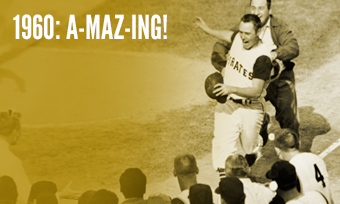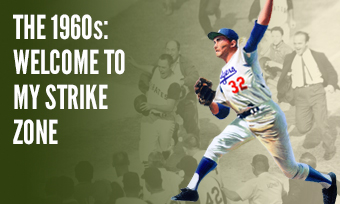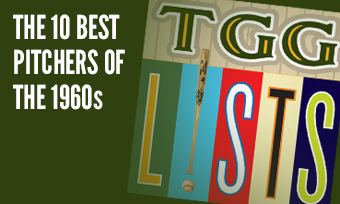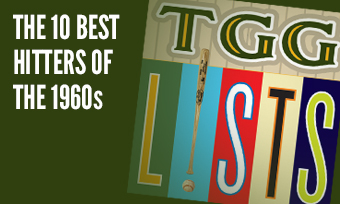The Yearly Reader
Leaders and Honors, 1960
Our list of baseball’s top 10 hitters and pitchers in both the American League and National League for the 1960 baseball season, as well as the awards and honors given to the game’s top achievers of the year.
The National League’s Top 10 Hitters, 1960
Bold type in brick red indicates league leader.
1. Eddie Mathews, Milwaukee
Key Numbers: .277 average, 108 runs, 39 home runs, 124 RBIs, 111 walks.
For the only time in his career, Mathews hit the quadruple-triple—collecting 100+ runs, RBIs, walks and strikeouts each. Power aside, his biggest hits of the year came when he battered and bruised Frank Robinson after the Reds’ star crashed a little too aggressively into him at third base.
2. Hank Aaron, Milwaukee
Key Numbers: .292 average, 102 runs, 172 hits, 20 doubles, 11 triples, 40 home runs, 126 RBIs, 12 sacrifice flies, 16 stolen bases.
Though he finished second in the NL home run race, Aaron reigned as the virtual winner of the Home Run Derby TV show filmed at Los Angeles’ Wrigley Field.
3. Willie Mays, San Francisco
Key Numbers: .319 average, 107 runs, 190 hits, 29 doubles, 12 triples, 29 home runs, 103 RBIs, 25 stolen bases.
Mays overcame Candlestick Park’s cavernous power alleys (to be reduced a year later) and still managed to put up All-Star numbers.
4. Frank Robinson, Cincinnati
Key Numbers: 139 games, .297 average, 86 runs, 33 doubles, 6 triples, 31 home runs, 83 RBIs, 82 walks, 9 hit-by-pitches, 13 stolen bases, .595 slugging percentage.
Robinson led the NL for the third time in five years in HBP (hit by pitches), and for the first time in HBM (hit by Mathews—see above).
5. Ken Boyer, St. Louis
Key Numbers: .304 average, 95 runs, 168 hits, 26 doubles, 10 triples, 32 home runs, 97 RBIs.
For the third straight year, Boyer—who also set a career high in home runs—had to hit hot over the late summer to raise his year-end season average just over the .300 barrier, batting .370 over his last 62 games.
6. Ernie Banks, Chicago
Key Numbers: 156 games, .271 average, 94 runs, 162 hits, 32 doubles, 7 triples, 41 home runs, 117 RBIs, 71 walks, 28 intentional walks.
Banks was a one-man wrecking crew for the Cubs, amassing an RBI total nearly twice that of the next best Cub while setting a then-major league mark for intentional walks.
7. Orlando Cepeda, San Francisco
Key Numbers: .297 average, 81 runs, 169 hits, 36 doubles, 24 home runs, 96 RBIs, 15 stolen bases.
The Baby Bull, with a relatively mild September slump, barely failed to hit above .300 for the only time over his first seven seasons.
8. Vada Pinson, Cincinnati
Key Numbers: .287 average, 652 at-bats, 107 runs, 187 hits, 37 doubles, 12 triples, 20 home runs, 61 RBIs, 32 stolen bases.
A worthy encore for the 1959 breakout center fielder, leading the NL for the second straight season in doubles.
9. Don Hoak, Pittsburgh
Key Numbers: .282 average, 97 runs, 24 doubles, 9 triples, 16 home runs, 79 RBIs, 74 walks.
Settled in, for the moment, in his fourth of five National League cities for what would be his longest tenure (four seasons), Hoak enjoyed his finest campaign and led the champion Bucs with a .811 OPS (on-base plus slugging percentages).
10. Roberto Clemente, Pittsburgh
Key Numbers: .314 average, 89 runs, 179 hits, 22 doubles, 6 triples, 16 home runs, 94 RBIs, 21 grounded into double plays.
It took six years, but Clemente finally began his ascension toward legend. Left-handed pitchers whole-heartedly believed he was already there; he hit .398 against them in 1960.
The American League’s Top 10 Hitters, 1960
1. Mickey Mantle, New York
Key Numbers: .275 average, 119 runs, 17 doubles, 6 triples, 40 home runs, 94 RBIs, 111 walks, 125 strikeouts, 14 stolen bases.
Mantle overcame a spring training squabble over a pay cut and proved to the Yankees that they were wrong to do it.
2. Roger Maris, New York
Key Numbers: 136 games, .283 average, 98 runs, 18 doubles, 7 triples, 39 home runs, 112 RBIs, 70 walks, .581 slugging percentage.
Maris arrived in New York but surprisingly saved his power for the road, hitting 26 of his 39 homers away from Yankee Stadium. He then edged out Mantle for the AL MVP by a 225-222 count.
3. Roy Sievers, Chicago
Key Numbers: 127 games, .295 average, 87 runs, 28 home runs, 93 RBIs, 74 walks, 8 intentional walks.
The most impressive thing about the career slugger who never produced an impressive batting average was that he put together the majors’ longest hit streak of 1960 (21 games).
4. Minnie Minoso, Chicago
Key Numbers: 154 games, .311 average, 89 runs, 184 hits, 32 doubles, 20 home runs, 105 RBIs, 13 hit-by-pitches, 9 sacrifice flies, 17 stolen bases, 13 caught stealing.
Perhaps the White Sox set up the exploding scoreboard at Comiskey Park just to celebrate the return of the popular Minoso after two years in Cleveland.
5. Jim Lemon, Washington
Key Numbers: .269 average, 81 runs, 10 doubles, 38 home runs, 100 RBIs, 8 intentional walks, 9 sacrifice flies.
There was little stopping at second for Lemon, whose 3.8-1 home runs-to-doubles ratio was the highest for anyone hitting 30 or more homers until Dave Kingman in 1982.
6. Tito Francona, Cleveland
Key Numbers: .292 average, 84 runs, 36 doubles, 17 home runs, 79 RBIs.
Awarded everyday play after his remarkable .363 showing a year earlier, Francona was slowed only by a substandard .254 average at home. (He hit .332 away from Cleveland.)
7. Harmon Killebrew, Washington
Key Numbers: 124 games, .276 average, 84 runs, 31 home runs, 80 RBIs, 71 walks.
After a tepid start, Killebrew applied the after-burners and launched 21 of his 30 homers after August 1.
8. Bill Skowron, New York
Key Numbers: .309 average, 34 doubles, 26 home runs, 91 RBIs.
Advised to take up swimming to strengthen unusually tight muscles, Skowron began a three-year stretch that would be the finest of his 14-year career.
9. Ted Williams, Boston
Key Numbers: 113 games, .316 average, 29 home runs, 72 RBIs, 75 walks.
A grand, final hurrah for the Splendid Splinter, who even as he surpassed his 42nd birthday proved that he was second to none among his much younger teammates.
10. Al Smith, Chicago
Key Numbers: .315 average, 80 runs, 169 hits, 31 doubles, 12 home runs, 72 RBIs.
No one was happier about the return of Minnie Minoso to Chicago than Smith, who’d been targeted by White Sox fans two years earlier for being the guy the team traded Minoso to Cleveland for.
The National League’s Top 10 Pitchers, 1960
1. Bob Friend, Pittsburgh
Key Numbers: 3.00 ERA, 18 wins, 12 losses, 37 starts, 275.2 innings, 45 walks, 25 grounded into double plays.
After an off-year where he was overweight, Friend thinned out the pounds and put on extra wins in a campaign that earned him Comeback Player of the Year honors.
2. Vern Law, Pittsburgh
Key Numbers: 3.08 ERA, 20 wins, 9 losses, .690 win percentage, 35 starts, 18 complete games, 271.2 innings, 40 walks, 33 grounded into double plays.
The rule of Law: The prime-time Pirate won 20 regular season games, two World Series contests, and one of two All-Star games.
3. Lew Burdette, Milwaukee
Key Numbers: 3.36 ERA, 19 wins, 13 losses, 4 saves, 45 appearances, 32 starts, 18 complete games, 275.2 innings, 35 walks, 30 grounded into double plays.
Burdette was Everyman for the Braves, winning, relieving, saving—and throwing the first no-hitter of his pro career, part of a 33-inning scoreless streak that was, at the time, the second longest in Braves history.
4. Ernie Broglio, St. Louis
Key Numbers: 2.74 ERA, 21 wins, 9 losses, .700 win percentage, 52 appearances, 24 starts, 226.1 innings, 100 walks, 23 grounded into double plays.
The future trivia answer to “Who was traded for Lou Brock” pitched well enough to have made that deal seem, at the time, like a win-win for both teams involved.
5. Mike McCormick, San Francisco
Key Numbers: 2.70 ERA, 15 wins, 12 losses, 3 saves, 40 appearances, 34 starts, 253 innings, 12 wild pitches, 17 stolen bases allowed.
The former bonus baby had Candlestick Park primarily to thank for his breakthrough season—posting a 10-4 record and 1.65 ERA at the Giants’ new yard.
6. Warren Spahn, Milwaukee
Key Numbers: 3.51 ERA, 21 wins, 10 losses, .677 win percentage, 40 appearances, 33 starts, 18 complete games, 266.2 innings, 25 grounded into double plays.
Perhaps inspired by watching teammate Lou Burdette throw his first career no-hitter, Spahn went out and, less than a month later, pitched his first no-no—at age 39.
7. Don Drysdale, Los Angeles
Key Numbers: 2.84 ERA, 15 wins, 14 losses, 41 appearances, 36 starts, 269 innings, 246 strikeouts, 10 hit-by-pitches, 23 grounded into double plays.
An up-and-down (but still effective) campaign was reflected in a 0-5 record and 5.45 ERA in June—followed by a 6-0 July with a 2.00 figure; overall, opponents batted just .215 against him.
8. Lindy McDaniel, St. Louis
Key Numbers: 2.09 ERA, 12 wins, 4 losses, .750 win percentage, 27 saves, 65 appearances, 2 starts, 116.1 innings, 24 walks.
McDaniel’s 27 saves—at the time, a NL record—didn’t include the two he collected closing out both All-Star Games.
9. Sam Jones, San Francisco
Key Numbers: 3.19 ERA, 18 wins, 14 losses, 39 appearances, 35 starts, 234 innings, 91 walks.
Jones lost a bid for a second career no-no, allowing an eighth-inning HR to Cubs’ Walt Moryn in his second start of year.
10. Larry Jackson, St. Louis
Key Numbers: 3.48 ERA, 18 wins, 13 losses, 43 appearances, 38 starts, 282 innings.
The workhorse of the year, Jackson was at his best in mid-spring when he won eight straight starts.
The American League’s Top 10 Pitchers, 1960
1. Frank Baumann, Chicago
Key Numbers: 2.67 ERA, 13 wins, 6 losses, .684 win percentage, 4 saves, 47 appearances, 20 saves, 185.1 innings, 33 grounded into double plays.
Pricey Boston bonus baby Baumann delivered in Chicago after the Red Sox couldn’t get much out of him for five years.
2. Jim Bunning, Detroit
Key Numbers: 2.79 ERA, 11 wins, 14 losses, 34 starts, 252 innings, 201 strikeouts, 11 hit-by-pitches, 27 grounded into double plays.
Only Baumann had a better ERA than Bunning—but 19 AL pitchers in total won more games. Blame a Detroit offense that scored an average of just 3.2 runs every time Bunning started.
3. Jim Perry, Cleveland
Key Numbers: 3.62 ERA, 18 wins, 10 losses, .643 win percentage, 41 appearances, 36 starts, 4 shutouts, 261.1 innings, 26 grounded into double plays.
With young brother Gaylord waiting in the wings, Jim Perry was for now the better-known pitcher of the family.
4. Chuck Estrada, Baltimore
Key Numbers: 3.58 ERA, 18 wins, 11 losses, 36 appearances, 25 starts, 208.2 innings, 101 walks, 15 hit-by-pitches.
Estrada was the most successful of four very young, very talented Orioles starters in a rotation nicknamed “The Diaper Squad.”
5. Whitey Ford, New York
Key Numbers: 3.08 ERA, 12 wins, 9 losses, 4 shutouts, 33 appearances, 29 starts, 192.2 innings.
Ford’s muted numbers could be tied to the fact that he rarely pitched against either the Red Sox or A’s. Here’s why: In four appearances against those two teams, he was 0-2 with an 8.31 ERA.
6. Jack Fisher, Baltimore
Key Numbers: 3.41 ERA, 12 wins, 11 losses, 40 appearances, 20 starts, 197.2 innings.
The career 86-139 pitcher enjoyed his one year (out of 11) in which he finished with a winning record—and he still got tagged as a victim of history by serving up Ted Williams’ final home run.
7. Frank Lary, Detroit
Key Numbers: 3.51 ERA, 15 wins, 15 losses, 36 starts, 15 complete games, 274.1 innings, 19 hit-by-pitches, 26 grounded into double plays.
The Detroit ace must have been in a particularly foul mood on July 21 against Washington when he hit four players—including a beaning of Reno Bertoia, who had to be carried off on a stretcher.
8. Jack Kralick, Washington
Key Numbers: 3.04 ERA, 8 wins, 6 losses, 35 appearances, 18 starts, 151 innings, 0 stolen bases allowed, 22 grounded into double plays.
A fine year for the rookie curveballer, starting in the bullpen before a worthy promotion to the rotation.
9. Gerry Staley, Chicago
Key Numbers: 2.42 ERA, 13 wins, 8 losses, 9 saves, 64 appearances, 0 starts, 115.1 innings, 25 walks.
The 40-year-old ex-Cardinals starter, who pitched his final 281 games exclusively out of the bullpen, continued to live major league life as the White Sox’ closer thanks to a knuckleball he gradually embraced.
10. Camilo Pascual, Washington
Key Numbers: 3.03 ERA, 12 wins, 8 losses, 26 appearances, 22 starts, 151.2 innings, 143 strikeouts.
Pascual managed to grab a winning record with a below-.500 Senators team for the second straight year; his 8.5 strikeouts per nine innings were the highest among AL pitchers with 100 or more innings.









